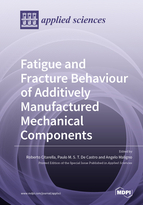Fatigue and Fracture Behaviour of Additively Manufactured Mechanical Components
A special issue of Applied Sciences (ISSN 2076-3417). This special issue belongs to the section "Mechanical Engineering".
Deadline for manuscript submissions: closed (15 September 2019) | Viewed by 29097
Special Issue Editors
Interests: fracture mechanics; fatigue; bioengineering; vibroacoustics; boundary element method; finite element method; statistical energy analysis; dynamics
Special Issues, Collections and Topics in MDPI journals
Interests: fatigue; fracture; residual stresses; structural connections; structural integrity
Interests: advanced materials; computational modelling; aerospace defense; damage; fracture mechanics
Special Issues, Collections and Topics in MDPI journals
Special Issue Information
Dear Colleagues,
The advent of additive manufacturing (AM) processes applied to the fabrication of structural components creates the need for design methodologies supporting structural optimization approaches that take into account the specific characteristics of the process. While AM processes give unprecedented geometrical design freedom, which can result in significant reductions of component weight (e.g., through part count reduction), on the other hand they have implications in the fatigue and fracture strength due to residual stresses and microstructural features. This is linked to stress concentration effects and anisotropy that still need research.This Special Issue of Applied Sciences aims at bringing together papers investigating features of AM processes with relevance to the mechanical behavior of AM structural components, particularly, but not exclusively, from the viewpoints of fatigue and fracture behavior. Although the focus of the issue is on AM problems related to fatigue and fracture, articles dealing with other manufacturing processes with related problems can also be included, in order to establish differences and potential similarities.The submission of papers on numerical simulation or reporting experimental work, or a combination of both, is welcome. The application of damage and fracture mechanics concepts, the appraisal of stress concentration effects, and the consideration of residual stresses and anisotropic behavior will be of particular interest for a range of AM structural applications that can be foreseen to go from biomedical engineering to aerospace components.
Prof. Dr. Roberto Citarella
Prof. Dr. Paulo de Castro
Prof. Dr. Angelo Maligno
Guest Editors
Manuscript Submission Information
Manuscripts should be submitted online at www.mdpi.com by registering and logging in to this website. Once you are registered, click here to go to the submission form. Manuscripts can be submitted until the deadline. All submissions that pass pre-check are peer-reviewed. Accepted papers will be published continuously in the journal (as soon as accepted) and will be listed together on the special issue website. Research articles, review articles as well as short communications are invited. For planned papers, a title and short abstract (about 100 words) can be sent to the Editorial Office for announcement on this website.
Submitted manuscripts should not have been published previously, nor be under consideration for publication elsewhere (except conference proceedings papers). All manuscripts are thoroughly refereed through a single-blind peer-review process. A guide for authors and other relevant information for submission of manuscripts is available on the Instructions for Authors page. Applied Sciences is an international peer-reviewed open access semimonthly journal published by MDPI.
Please visit the Instructions for Authors page before submitting a manuscript. The Article Processing Charge (APC) for publication in this open access journal is 2400 CHF (Swiss Francs). Submitted papers should be well formatted and use good English. Authors may use MDPI's English editing service prior to publication or during author revisions.
Keywords
- Fatigue
- Fracture
- Additive manufacturing
- FEM








